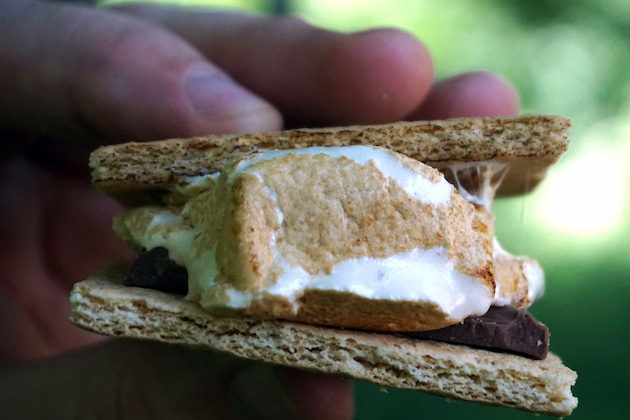Cornell Corner
Cornell touts new maple marshmallows recipes
Maple marshmallow treat could be great new product for producers
By CATHERINE BELISLE, PH.D. AND AILIS CLYNE | JANUARY 6, 2023
ITHACA, N.Y.—Have you Googled maple marshmallows?
This twist on a classic treat is not commonly found on market shelves, at least not yet.
The Cornell Maple Program has been working on adapting gourmet marshmallow procedures for a recipe that uses maple as the only sweetener, and the results pack a lot of maple flavor.
The new gourmet maple marshmallow recipe uses a combination of granulated maple sugar and inverted maple syrup, water, gelatin, and air.
As with all confections, each ingredient has its role. The granulated sugar provides sweetness and structure, while the inverted syrup contributes flavor and prevents crystallization for silky smooth texture.
A small amount of water is necessary to prevent the sugar from burning and to provide moisture in the final product.
Lastly, gelatin is essential for that bouncy texture marshmallows are famous for. The gelatin preserves the air bubbles that are incorporated into the confection by high-speed whipping.
Best of all, this new recipe results in an adaptable product.
These marshmallows can be used to make s’more-ready gourmet marshmallows, dehydrated mini marshmallows for hot cocoa or cereal, marshmallow-based spreads like Fluff, and so much more.
The full recipe, guidelines, cost-per-unit, and storage and packaging recommendations will be available soon on the “New Product Development” page at cornellmaple.com (https://blogs.cornell.edu/cornellmaple/product-development-and-research/).
The marshmallow market in the United States has a value of $342 million and is projected to grow to $535 million by 2028 according to Fortune Business Insights*.
This growth can be attributed to an increased demand for premium and artisanal confectionery products.
Companies such as Smashmallow are dedicating their businesses to large scale production of “premium” marshmallows.
These premium marshmallows that are contributing to market growth are including “all-natural” on their labels, using organic cane sugar, and developing a wide array of unique flavors to draw both adventurous and health-conscious consumers.
Health-conscious consumers are still in the market for sweet treats, and maple sugar can help fill that market niche for “all-natural” confections.
Last month, the Cornell Maple Program released their research findings and improved recipe for Maple Marshmallows.
An extensive bulletin on the subject can be found on the New Product Development page of the Cornell Maple Program website (https://blogs.cornell.edu/cornellmaple/product-development-and-research/).
In addition to the recipe reprinted below, the bulletin contains information on marshmallow composition, troubleshooting, regulations, packaging, food additives, market projections, and pricing information. These guidelines are intended for commercial production.
Maple Marshmallow (3:2 Ratio1) Recipe
By Catherine Belisle, Ph.D., Ailis Clyne (2022).
Ingredients
12 (30 g) Silver Gelatin Sheets2
330 g Granulated Maple Sugar
328 g Inverted Dark Maple Syrup3
118 g (½ cup) Water
Pinch of salt (optional)
Powdered Maple Sugar4
1. For a 1:1 ratio, use 273 g granulated maple sugar, and 408 g inverted maple syrup.
2. To substitute powdered gelatin, use 1 packet for every 4 gelatin sheets (Joachim and Schloss, n.d.). Knox brand powdered gelatin has an approximate Bloom strength of 225 and contains about 7 g of gelatin per packet. Bloom strength and g per packet varies by manufacturer.
3. To fully invert maple syrup, add 1 tsp of invertase per gallon of syrup. For rapid conversion, hold maple syrup with invertase at 120 – 150 °F for 24 hours. Where time is not a factor, stir the solution thoroughly and store at room temperature for 3 - 5 days.
4. Basic instructions for Powdered Maple Sugar are provided at the end of this recipe.
Directions
1. Submerge gelatin sheets in cold water until softened (10 - 15 minutes).
2. While gelatin is rehydrating, use a neutral-flavored oil to lightly coat two 8” x 8” baking pans, plastic wrap to cover the marshmallows while they set, and a rubber spatula. Remove excess oil with a paper towel.
3. Squeeze rehydrated gelatin sheets to remove excess water, and place them into a double boiler. Heat on low until the gelatin is liquid (2 - 3 minutes), taking care not to overheat.
4. Transfer liquid gelatin into a stand mixer with whisk attachment. Gelatin will gel as it cools and liquefy again as the hot syrup is added to the stand mixer.
5. In a medium saucepan, add the granulated maple sugar, inverted maple syrup, water, and salt. Heat to 245 °F. Immediately remove from heat and allow to cool to 6. Once the syrup has cooled, turn the stand mixer on low. Slowly add the cooled syrup to the gelatin by pouring it down the side of the mixing bowl. Be careful not to allow hot syrup to hit the moving whisk attachment as it can spatter and cause burns.
7. Increase stand mixer speed to high and continue to mix for 10 – 12 minutes.
8. Working quickly, use the rubber spatula to deposit the marshmallow mixture into the baking pans and spread evenly. Gently cover and press the oiled plastic wrap onto the exposed surface of the marshmallow to avoid formation of a crust. Allow the marshmallows to set at room temperature for 6 – 24 hours.
9. Coat a cutting board with Powdered Maple Sugar. Use lightly oiled hands to release the edges of the marshmallow from the baking pan onto the cutting board. Using a lightly oiled knife, cut the marshmallows into squares.
10. As each marshmallow is cut, coat completely with Powdered Maple Sugar. Shake excess powdered sugar off of the marshmallows using sifter.
11. Store marshmallows in an air-tight container for up to 3 weeks.
Recipe makes approximately 725 g.



































